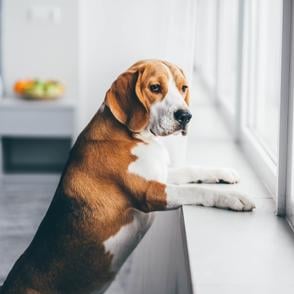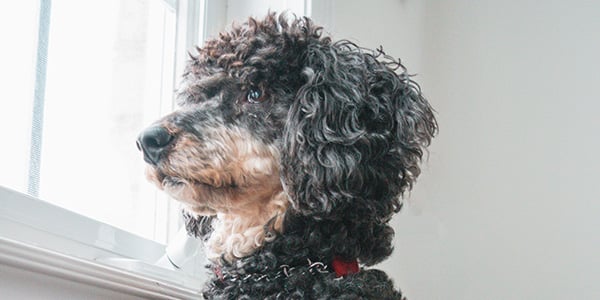If your dog panics when left home alone, they may be suffering from separation anxiety. No one wants their dog to be anxious, and a dog who has separation anxiety may cause damage to your home, cause tension between neighbors, and make regular life activities difficult. With management and treatment, separation anxiety can be overcome.
Quick Links

There is no single definite cause of separation anxiety in dogs. Separation anxiety can be a result of a variety of factors. These include:
Our mission is to help save dogs' and cats’ lives through our educational content. To support our efforts, this page may contain affiliate links. We earn a commission for qualifying purchases – at no cost to you.
Separation anxiety is a behavioral disorder that affects 1 in 7 dogs. It is a particular state of fear and panic that dogs experience when they are left alone (isolation distress) or separated from a certain person (separation anxiety).
There are varying levels of severity. While a dog with mild separation anxiety may simply be restless when alone, a dog with severe separation anxiety may exhibit panic attack symptoms (see list below) and injure themselves in their distress.
In many cases, a dog will start to show anxious behaviors when they think they are about to be left alone due to the anticipation of being alone or away from their person. This may start quite a long time before someone actually leaves. Some dogs with separation anxiety are okay when their person leaves, but cannot handle more than a certain length of time alone.
Because separation anxiety is an anxiety disorder, it can only be formally diagnosed by a veterinarian or veterinary behaviorist. If you notice any of the symptoms below, discuss them with your veterinarian to explore whether your dog truly has anxiety or may instead be exhibiting typical puppyhood behaviors or behavior due to other stress or boredom.
Dog Separation Anxiety Resources Page
Take the Quiz: Does My Dog Have Separation Anxiety?
Dog Anxiety Medication, Supplements, and Treatment
Dog Owner Survey: What Separation Anxiety Treatment Has Worked for You?
In order to prevent your dog from becoming anxious, you need to watch their body language for signs they are starting to worry, and immediately return before they exhibit more serious symptoms. Using a pet camera and watching live via the connected smartphone app makes this easier, both for management during absence suspension (step 5) and means that your at-home treatment (step 6) is most effective.
When working with your dog trainer to treat your dog's separation anxiety, you'll soon realize that you need an easy way to watch your dog via a pet camera and be able to record your training sessions. You will start off with taking a "baseline" – typically a one-minute-long recorded departure, to gauge your dog's anxiety symptoms and identify their initial anxiety trigger.
If working with a behavior consultant, they will be asking you to record and share your treatment sessions so they can review them throughout the process. They will coach you on where to start your desensitization repetitions (this is often much earlier in the departure process than most dog owners think it will be) and when to add in the next steps.
Learn what pet cameras are best and how to set up video monitoring for separation anxiety treatment here.
One way to reduce stress and anxiety is to make sure your dog is getting sufficient physical exercise and mental enrichment. While every dog's physical exercise needs are unique based on size, breed, age, and health, a good rule of thumb is a minimum of 30 minutes a day.
Increase mental enrichment by incorporating interactive dog feeders and puzzles for every meal, practicing fun training skills in multiple short training sessions every day, going for long decompression walks where your dog can sniff, and providing appropriate edible chews. Three activities, in particular, are naturally calming for dogs: licking, chewing, and sniffing.
Find inspiration for increasing your dog's enrichment in Dog Enrichment: Toys, Games, and DIY Ideas.
While food puzzles used to be a part of treatment for separation anxiety, an increasing number of behavior consultants are not including food-stuffed toys or other treats in their treatment plans anymore. Why is this?
If a dog is in a state of panic, they are not likely to even want the food, as their sympathetic nervous system activates their fight-flight-freeze responses and dampens their appetite. And in many cases, dogs who do eat are "stress eating" — eating so rapidly that it has no effect on their emotional response.
Food can distract some dogs when you leave but does nothing to ease their panic when they finish and realize you are gone. This makes establishing a dog's baseline and planning out initial treatment steps more difficult. Often, the act of grabbing a food-stuffed puzzle became an anxiety trigger for dogs, as it predicted their owner's departure.
To counteract these potential consequences of using food, treatment relies primarily on systematic desensitization (outlined below). However, food and treat puzzles are often a significant part of enrichment and other training exercises to help reduce overall stress and increase a dog's confidence while you're at home with them.

For mild cases of separation anxiety, often incorporating supplements or medication is enough to help your dog feel better about being left alone. For moderate to severe cases, anti-anxiety medication can reduce the intensity of anxiety your dog is feeling and increase the speed and effectiveness of behavior modification treatment. It is beneficial to consider anxiety medication early in the treatment of your dog's separation anxiety.
WARNING: Check with your veterinarian before giving your dog calming supplements, as some supplement ingredients can have adverse side effects when given with certain prescription medications or medical conditions.
Available calming supplements are not well-regulated, making it crucial that you carefully research what supplement to give your dog. Look for ingredients such as L-theanine, L-tryptophan, and alpha-casozepine. Vitamin B treatments can also be a helpful supplement, and you can speak with your veterinarian about testing your dog's current levels and supplement options. Probiotics can also play an integral role in easing your dog's anxiety, as gut health is linked to behavioral health.
There are many different types of prescription anxiety medication, from short-acting to long-acting medication. Your veterinarian can help you decide what medication may be the best option to try with your dog based on their anxiety symptoms and frequency. For long-acting anxiety medication, a drug trial can last 6–8 weeks, and adjustments in dosages or switching medications are common. If you don't notice a positive effect right away or notice undesirable side effects, that doesn't mean that medication won't help your dog – they may respond better to a different drug class.
Additional treatment for canine separation anxiety can include tPEMF treatments, acupuncture, massage, calming pheromones, and calming shirts/wraps.
For more information, visit Dog Anxiety Medication, Supplements, and Treatment.
Before you can begin treatment for moderate to severe separation anxiety, you'll need to suspend all absences — never leaving your dog alone for longer than they can handle. To do so, make a list of friends, family members, or neighbors who may be able to help you by staying with your dog when you need to leave. If your dog enjoys and does well at dog daycare or with a pet sitter, these can be more options for where your dog goes when you need to leave them.
If your dog has moderate to severe separation anxiety, you'll want to connect with your veterinarian and a certified canine behavior consultant to begin anxiety management and treatment. Having both of these professionals as your support team will help you and your dog in a variety of ways, as they will help you personalize anxiety management and treatment.
When choosing a dog trainer to help you with your dog's separation anxiety, look for someone experienced in anxiety cases. There are many certifications within the dog training industry. Trainers with the designation of CSAT (Certified Separation Anxiety Trainer) or Cert. SAPT (Certified Separation Anxiety Pro Trainer) specialize in separation anxiety cases. However, many certified behavior consultants (CBCC-KA, CDBC) also take anxiety cases.
Learn more about dog trainer certifications here.

Prior to starting systematic desensitization with your dog to treat their separation anxiety, you must commit to never leaving them alone for longer than they can handle. Every time they experience anxiety when left alone, the behavior pattern and negative emotional response are strengthened, increasing their anxiety over time. To combat this, we suspend all absences — not leaving your dog alone at all. This break from absences gives your dog's brain a chance to flush out stress and prevents the rehearsal of anxiety symptoms.
For mild cases, this might mean you can leave them alone for 5 or 10 minutes at a time. Having video monitoring available makes figuring out your dog's threshold for alone time much easier.
For moderate to severe cases, this can mean never leaving them by themselves until they have progressed through systematic desensitization treatment (explained in the next step). Having a support network is imperative to being able to do this. Connect with friends, family members, neighbors, pet sitters, or a dog daycare to explore your options.
Each dog is different in what they can handle — their "threshold" for separation — which is why it's important to know when your dog begins to exhibit subtle signs that their anxiety is triggered. A certified canine behavior consultant can help you determine your dog's threshold level via virtual consultations or by watching a recorded video of your dog's body language.
Systematic desensitization is a process by which you slowly expose your dog to the things that typically cause their separation anxiety. The goal is to change their negative association of your departure and absence to a neutral association, through low-level exposure and repetition.
Here's an example of the systematic desensitization process:
Current departure routine: Grab car keys. Put shoes on. Put on coat. Walk to the door. Calm "bye pup" to your dog. Open door. Exit home. Open garage door. Get in car. Drive away.
Take note of your dog's first trigger (showing subtle signs of increasing anxiety): When you put your shoes on they get up and start pacing.
First step: Grab keys. Put shoes on, take them off. Go back to "daily life." Repeat. Do so with calm energy and no extra attention to your dog. Stay with this step until your dog's response to you putting on your shoes is neutral.
Second step: Grab keys, put shoes on, put on coat. Take them off. Repeat until the dog's response is neutral.
Third step: Grab keys, put shoes on, put on coat, and walk to the door. Walk back, remove coat, shoes, etc. Repeat.
And so on. Everyone's departure routines are different, some short and some more involved. It can be helpful to sit down and write out your typical departure routine so you can easily split out the steps for desensitization.
As you progress through systematic desensitization, you start adding more steps of your departure routine. Over time, the process becomes your typical departure paired with short durations alone (such as 3 minutes while you retrieve your mail). With practice, this turns into longer-duration absences (running errands or going out to dinner). Having a pet camera set up for monitoring is crucial for this step so that you can ensure your dog is not exhibiting signs of increasing stress when you're not there, and so that you can return at the first sign they are starting to get anxious.
During this process, you never do more than your dog can handle. You only add on the next step of the routine when your dog is showing a neutral response to the previous step.
Systematic desensitization to treat separation anxiety is similar to what we use with young puppies to prevent separation anxiety, but it is more thoughtful and planned out.
Watch this video to see an example of what systematic desensitization looks like:
Treating separation anxiety is not a fast process and will take weeks to months of consistent management and practice.
Every dog's treatment journey is unique to them. The treatment duration depends on their initial anxiety levels, consistency in absence suspension and practicing systematic desensitization, and whether other concurrent anxieties they suffer from are also being addressed. In many cases, incorporating anti-anxiety medications or calming supplements can significantly speed up treatment time.
As mentioned above, every time your dog's anxiety is triggered it adversely affects treatment and can increase the severity of their anxiety. While it can be difficult to suspend all absences, it is an important step in helping your dog overcome separation anxiety.
Life happens. There may be times when leaving your dog alone for longer than they can cope with is inevitable. The goal is to reduce absences as much as possible during treatment, but if there are moments when your dog must be left alone, be aware of how it will affect treatment. It may result in needing to go back a few steps in the desensitization process or even starting from the beginning again. Incorporating supplements or prescription medications may help if you know that your dog has to be left alone before they are ready.
For dogs who struggle with being confined in a crate — or have never been crate trained at all — it is not recommended to use a crate to help with their separation anxiety. This is layering on another factor of stress and often increases their anxiety response, as well as further poisoning their perception of the crate. Crate training is a long process, and to reduce your own workload, it's easier to focus primarily on systematic desensitization for separation anxiety rather than combine that with crate training protocols. In these cases, to protect your home, use a large exercise pen or gate-off a dog-proofed area for your dog to stay in.
Crate training can be used, however, to help prevent separation anxiety, as proper crate training is essentially teaching your dog to relax when confined and away from you.
While getting another canine companion for a dog who suffers from separation anxiety sounds like a good idea, in most cases it does not fix the problem. The second dog can begin to exhibit their own separation anxiety based on the negative emotional responses they see in the first dog. Then you have two dogs with anxiety.
If the first dog's separation anxiety is triggered specifically by the absence of people or a specific person, another dog in the environment will not relieve their anxiety. However, if your dog has isolation distress (anxious when alone but not connected to human absence or specific-person absence) and this is eased by the companionship of another dog, it could be an option for you.
Adding another dog changes the family structure and routine in the home, and is initially stressful for all involved. It is recommended to first talk with a certified canine behavior consultant to define your dog's particular type of separation anxiety before deciding to bring home another dog.
A common symptom of separation anxiety is vocalization (barking, whining, howling), and in an effort to reduce disturbances to neighbors, many dog owners consider having their dog wear a bark collar. Please avoid the use of aversive tools like this if your dog is suffering from anxiety.
Bark collars, whether shock or citronella, apply physical punishment to your dog when they bark or howl. Being punished with an electric shock or unpleasant spray in the face will make a dog's anxiety worse. In some cases, bark collars are the cause of separation anxiety. If a dog is feeling worried or anxious, then receives punishment for vocalizing, the dog associates being alone with unpleasant things. This negative emotional association increases anxiety about the context of being alone, and the use of punishment can result in a dog becoming shut down in a state of learned helplessness. This will make actual treatment difficult.
The Pet InfoRx® is made possible, in part, through our partnership with AlignCare®.


© Preventive Vet. All rights reserved. PreventiveVet.com
